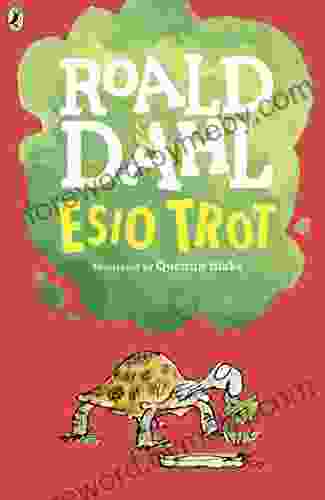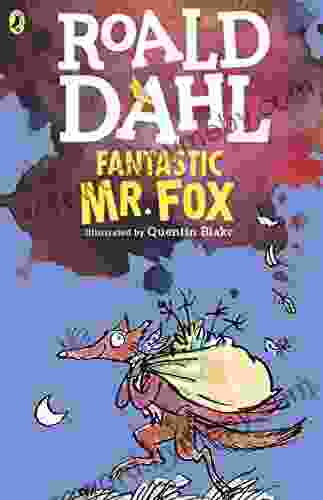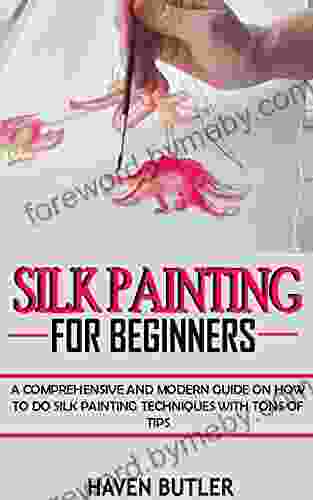Silk Painting: A Comprehensive Guide to Mastering the Art

Silk painting is an ancient and captivating art form that has been practiced for centuries. It involves applying dyes or paints to silk fabric to create vibrant and intricate designs. Silk painting offers endless creative possibilities, making it a popular choice for artists and hobbyists alike. Whether you're a complete beginner or looking to enhance your skills, this comprehensive guide will provide you with everything you need to know to master the art of silk painting.
4.2 out of 5
| Language | : | English |
| File size | : | 316 KB |
| Text-to-Speech | : | Enabled |
| Screen Reader | : | Supported |
| Enhanced typesetting | : | Enabled |
| Print length | : | 12 pages |
| Lending | : | Enabled |
Types of Silk Paint
Choosing the right type of paint is crucial for successful silk painting. Here are the most common types:
- Acid dyes: These dyes are vibrant and easy to use, making them a great choice for beginners. They are water-based and require the use of a mordant, a substance that helps the dye adhere to the silk.
- Fiber-reactive dyes: These dyes form a permanent bond with the silk fibers, resulting in rich and long-lasting colors. They are also water-based and require the use of a soda ash solution.
- Gutta: This is a resist medium used to outline designs or create separations between colors. It is made from natural rubber latex and prevents the paint from spreading beyond the applied lines.
Essential Silk Painting Techniques
Mastering silk painting involves learning a range of essential techniques. These include:
- Preparing the silk: Before painting, the silk must be properly prepared to ensure the paint adheres well. This involves washing and ironing the silk to remove any oils or impurities.
- Applying the dye: There are various methods for applying dye to silk, such as using brushes, sponges, or spray bottles. You can also create different effects by layering colors or using salt or alcohol to manipulate the dye.
- Blocking the silk: After the dye has been applied, the silk needs to be blocked to set the colors. This involves steaming or washing the silk to remove any excess dye and ensure the colors are permanent.
- Fixatives: Fixatives can be applied to the finished painting to protect it from fading or smudging.
Color Theory and Design in Silk Painting
Understanding color theory is essential for creating harmonious and visually appealing silk paintings. Color theory involves the principles of mixing and using colors to achieve desired effects. When choosing colors, consider the following:
- Color wheel: The color wheel is a tool that shows the relationships between colors. It can help you create color schemes and select complementary colors.
- Value: Value refers to the lightness or darkness of a color. By varying the value, you can create depth and dimension in your paintings.
- Intensity: Intensity refers to the saturation or purity of a color. Bright, intense colors can create a bold and vibrant effect, while softer, muted colors can create a more subtle and elegant look.
In addition to color theory, understanding design principles will help you create well-composed and visually appealing paintings. Some key design principles include:
- Balance: Balance refers to the distribution of visual weight in a painting. By arranging elements in a balanced way, you can create a sense of stability and harmony.
- Contrast: Contrast refers to the difference between elements in a painting. Using contrasting colors, values, or textures can create visual interest and depth.
- Movement: Movement refers to the use of lines, shapes, and colors to create a sense of motion in a painting. By using dynamic compositions, you can draw the viewer's eye through the painting and create a sense of energy.
Creative Applications of Silk Painting
Silk painting is not limited to creating framed artwork. Its versatility allows for a wide range of creative applications, including:
- Wearable art: Silk painting can be used to create unique and stylish clothing, scarves, and accessories.
- Home decor: Silk paintings can be used to create beautiful curtains, cushions, and wall hangings, adding a touch of elegance to your home.
- Art for gifts: Silk paintings make thoughtful and unique gifts for friends and family.
- Mixed media: Silk painting can be combined with other art forms, such as embroidery or beading, to create mixed media pieces.
Silk painting is a rewarding and versatile art form that offers endless creative possibilities. By mastering the essential techniques, understanding color theory and design principles, and experimenting with different creative applications, you can create stunning silk paintings that will add beauty and elegance to your life. Whether you're a beginner or an experienced artist, this comprehensive guide will provide you with the knowledge and inspiration to embark on your silk painting journey.
Ready to dive into the world of silk painting? Free Download your copy of our comprehensive guide today! This essential resource will guide you through every step of the process, from preparing the silk to creating stunning finished paintings. With detailed instructions, helpful tips, and inspiring examples, this guide will empower you to master the art of silk painting and create your own unique masterpieces.
4.2 out of 5
| Language | : | English |
| File size | : | 316 KB |
| Text-to-Speech | : | Enabled |
| Screen Reader | : | Supported |
| Enhanced typesetting | : | Enabled |
| Print length | : | 12 pages |
| Lending | : | Enabled |
Do you want to contribute by writing guest posts on this blog?
Please contact us and send us a resume of previous articles that you have written.
 Book
Book Novel
Novel Page
Page Chapter
Chapter Text
Text Story
Story Genre
Genre Reader
Reader Library
Library Paperback
Paperback E-book
E-book Magazine
Magazine Newspaper
Newspaper Paragraph
Paragraph Sentence
Sentence Bookmark
Bookmark Shelf
Shelf Glossary
Glossary Bibliography
Bibliography Foreword
Foreword Preface
Preface Synopsis
Synopsis Annotation
Annotation Footnote
Footnote Manuscript
Manuscript Scroll
Scroll Codex
Codex Tome
Tome Bestseller
Bestseller Classics
Classics Library card
Library card Narrative
Narrative Biography
Biography Autobiography
Autobiography Memoir
Memoir Reference
Reference Encyclopedia
Encyclopedia Ernest Small
Ernest Small Patricia Moore Pastides
Patricia Moore Pastides Felice Fox
Felice Fox Jihyun Park
Jihyun Park Fred Koehler
Fred Koehler Erik Qualman
Erik Qualman Sig Hansen
Sig Hansen Floella Benjamin
Floella Benjamin Michael Maslansky
Michael Maslansky F Martin Harmon
F Martin Harmon Matthew Polly
Matthew Polly Frederick Joseph
Frederick Joseph Fred Sirieix
Fred Sirieix Judy Converse
Judy Converse Fred M Grandinetti
Fred M Grandinetti Joshua Shifrin
Joshua Shifrin Joseph Vogel
Joseph Vogel Georgina Kleege
Georgina Kleege Fiona Holt
Fiona Holt Peg Dawson
Peg Dawson
Light bulbAdvertise smarter! Our strategic ad space ensures maximum exposure. Reserve your spot today!

 Floyd RichardsonThe Adventures of Chupacabra Charlie Latinographix: An Unforgettable Journey...
Floyd RichardsonThe Adventures of Chupacabra Charlie Latinographix: An Unforgettable Journey...
 Aleksandr PushkinThe History of Lloyd's and Marine Insurance in Great Britain: A Comprehensive...
Aleksandr PushkinThe History of Lloyd's and Marine Insurance in Great Britain: A Comprehensive...
 Bobby HowardTheoretical Insights Into Human Prehistory: Interdisciplinary Contributions...
Bobby HowardTheoretical Insights Into Human Prehistory: Interdisciplinary Contributions... Preston SimmonsFollow ·19.5k
Preston SimmonsFollow ·19.5k Gabriel HayesFollow ·5.4k
Gabriel HayesFollow ·5.4k Spencer PowellFollow ·3.8k
Spencer PowellFollow ·3.8k Cade SimmonsFollow ·8.3k
Cade SimmonsFollow ·8.3k Damon HayesFollow ·12.9k
Damon HayesFollow ·12.9k Clinton ReedFollow ·2k
Clinton ReedFollow ·2k Mitch FosterFollow ·6.1k
Mitch FosterFollow ·6.1k Jorge AmadoFollow ·10k
Jorge AmadoFollow ·10k

 Al Foster
Al FosterDive into the Enchanting World of Manatees: An...
Unveiling the Secrets of the Gentle...

 Isaac Mitchell
Isaac MitchellThe Farm Reggie and Friends: US Version - A Captivating...
A Heartwarming Tale that Embraces...

 Esteban Cox
Esteban CoxThe Interior Design Handbook: Your Comprehensive Guide to...
Are you ready to...

 William Wordsworth
William WordsworthFall Head Over Heels for "Esio Trot" by Roald Dahl: A...
Prepare to be charmed, amused, and utterly...

 Caleb Carter
Caleb CarterBlack Clover Vol Light Frida Ramstedt: A Thrilling...
Prepare to be spellbound by...

 Richard Simmons
Richard SimmonsFantastic Mr. Fox: A Literary Adventure That Captivates...
In the realm...
4.2 out of 5
| Language | : | English |
| File size | : | 316 KB |
| Text-to-Speech | : | Enabled |
| Screen Reader | : | Supported |
| Enhanced typesetting | : | Enabled |
| Print length | : | 12 pages |
| Lending | : | Enabled |






